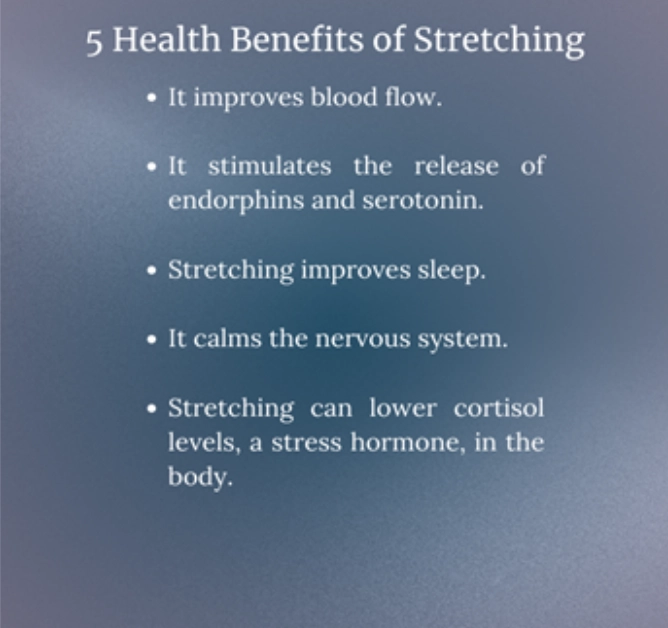How To Use Stretching To Optimize Your Sleep, Flexibility & Reduce Your Daily Stress

Are you interested in reducing your stress? Are your muscles tense all the time? A simple nighttime stretching routine may be all you need!
In my early forties, I was under a lot of stress. Despite my efforts to eat healthy and exercise regularly, I still had difficulty sleeping. So, I started a nighttime stretching routine and experienced better sleep in less than two weeks.
The Three Types of Stretching That Improve Your Flexibility
Muscle tightness occurs when there is increased tension in our bodies. The nervous system and the health of the muscles and connective tissues control this tension.
The three main types of stretching that improve muscle flexibility are:

- Static
- Dynamic
- Pre-contraction stretching
Static stretching involves holding a specific position with the muscle on tension. If you perform a static stretch, you will maintain the position for 15-30 seconds until you feel a mild stretch sensation in the muscle.
“Active dynamic stretching generally involves moving a limb through its full range of motion to the end ranges and repeating several times”.

“Pre-contraction stretching involves a contraction of the muscle being
stretched or its antagonist [opposing] muscle before stretching”. For example, if you want to stretch your hamstrings, you can tense or contract them for 5 seconds and then stretch them.
Or you can contract your quadriceps (the antagonist) for 5 seconds before stretching the hamstrings.
How Stretching Your Body Can Improve Your Sleep
Static stretching has a calming effect on the body. Stretching engages the connective tissues that connect the muscles, nerves, blood vessels, bones, and organs of the body.
“Low-intensity stretching before bed has been shown to reduce stress and improve the REM (rapid eye movement) stage of sleep”.

A great way to enhance the benefits of stretching before bed is to bring your attention to your breath. You can attend to the rhythm of each inhalation and exhalation, which makes a complete breath cycle (i.e., a total of about 6-8 seconds on average). Doing so will enhance your ability to quiet your mind, tracking your stretching hold times according to your breath instead of counting seconds.
How Static Stretching Calms the Nervous System and Reduces Your Stress
Gentle static stretching is soothing to the nervous system. It stimulates the “rest and digest” or parasympathetic branch of the autonomic or involuntary nervous system.

A study in the American Journal of Sports Science and Medicine found that static stretching increased parasympathetic dominance compared to pre-stretching autonomic nervous system measurements.
When the “rest and digest” branch stimulates a calming benefit in your body, it counterbalances the sympathetic or “fight-flight” branch of the autonomic nervous system (ANS). The “fight-flight” branch of the ANS is the branch that becomes overstimulated when we are stressed.
Activities and lifestyle habits, like stretching and a healthy diet, will enhance parasympathetic activity and are necessary to counterbalance or reduce the effects of sympathetic nervous system overload.
Stretching can also calm your body by improving blood flow or circulation, stimulating the release of endorphins (natural pain relievers) and serotonin (a neurotransmitter that improves mood), and reducing levels of the body’s primary stress hormone, cortisol.
Final Word
A daily stretching program improves our health and well-being in the following three ways:
- Stretching improves the flexibility of our muscles, tendons, ligaments, and connective tissues.
- Low-intensity stretching improves the REM stage of sleep.
- Gentle static stretching calms the body by stimulating the parasympathetic, or “rest and digest,” part of the nervous system.
Do you want to learn more about the health benefits of stretching? Connect with an experienced physical therapist, yoga instructor, or personal trainer in your area and get started today!
If you live in the Long Island, NY, area and want to learn more about stretching, you can connect with us here: 👉 https://montaltopt.com/specialties/stretching/
My intention is to educate, engage, and inspire you on your health journey. Thanks for reading!
Further Reading
- https://www.researchgate.net/publication/274517864_Acute_Changes_in_Autonomic_Nerve_Activity_during_Passive_Static_Stretching
- https://pubmed.ncbi.nlm.nih.gov/28780647/
- https://www.researchgate.net/publication/286575353_Effect_of_low-intensity_stretching_exercises_on_sleep_and_stress_in_people_with_mild_sleep_disorders
- https://www.ncbi.nlm.nih.gov/pmc/articles/PMC3273886/
